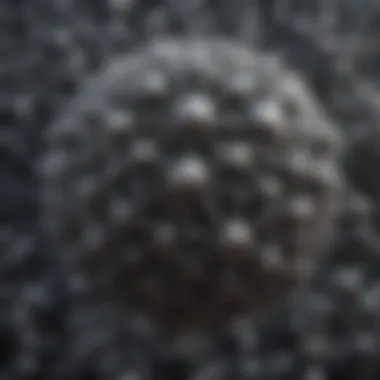Unveiling the Wonders of Graphite: A Deep Dive into Carbon Allotropes


Rock and Fossil Identification
Graphite, a marvel among carbon allotropes, holds a distinct place in various industries due to its exceptional properties and characteristics. Unlike other forms, its atomic structure allows for multiple layers which impart strength, flexibility, and conductivity. Tracing its origins back to the natural processes of heat and pressure on organic material, graphite showcases a unique arrangement of carbon atoms that give it its remarkable attributes. However, differentiating graphite from other carbon forms can be challenging for novices. Its distinct metallic luster and greasy feel are key characteristics to identify graphite, along with its ability to leave marks on surfaces. Utilizing basic tools like a pencil and paper can help in preliminary identifications, as graphite's smooth texture and darkness are distinctive.
Geological Insights
The geological relevance of graphite provides a fascinating insight into Earth's carbon cycle and the transformation of carbonaceous materials under immense pressure and heat. From its formation within the Earth's crust to its extraction in graphite-rich regions, understanding the geological processes that lead to graphite's creation enhances appreciation for this versatile material. Developed over millions of years through the metamorphism of organic material, graphite signifies a snapshot of Earth's history and the transformative forces at play beneath its surface. Notable geological formations where graphite is abundant offer clues to past environments and tectonic activities, shedding light on the planet's dynamic evolution over time. The discovery of graphite deposits in key geological settings has fueled scientific inquiry into alternative energy sources and advanced materials, paving the way for innovative technologies and sustainable solutions.
Introduction to Graphite
Graphite, a pivotal member of the carbon allotrope family, holds a paramount position in numerous industrial applications due to its exceptional properties and unique characteristics. Its significance lies in its versatility and indispensability across various industries, making it a material of choice in today's technological landscape. As we delve deeper into the realms of graphite, we unravel the intricate details of its atomic structure and the extensive utility it offers across different sectors. By exploring the essence of graphite, we gain a profound understanding of its profound impact on modern technology and innovation.
Definition of Graphite
Carbon Allotrope Overview:
In the intricate web of carbon allotropes, Graphite shines as a prominent figure. Its distinctive layered structure and excellent electrical conductivity contribute significantly to its widespread use across industries ranging from metallurgy to electronics. The layered characteristic of Graphite allows for easy slippage between layers, making it an ideal choice for lubrication applications and heat insulation.
Atomic Structure:
The atomic structure of graphite consists of hexagonally arranged carbon atoms bonded together in strong covalent bonds. This unique arrangement imparts remarkable strength and stability to graphite's structure, making it a preferred material for high-temperature furnaces and refractories. Despite its robust nature, the atomic structure of graphite also offers flexibility, allowing for the formation of graphene derivatives with exceptional properties.
Historical Significance
Early Uses:
Throughout history, graphite found its utility in various early applications such as writing implements and lubricants due to its smooth texture and excellent conductivity. This versatility made graphite a valuable commodity in ancient times, showcasing its enduring presence in human civilization.
Discovery and Naming:
The discovery and naming of graphite mark a significant milestone in the field of materials science, shedding light on the remarkable properties of this carbon allotrope. From its initial uses in pencil manufacturing to its modern-day applications in nuclear reactors and lithium-ion batteries, graphite's journey from discovery to innovation showcases its enduring relevance and adaptability.
Physical Characteristics
Color and Luster:
The distinct dark gray hue and metallic luster of graphite set it apart from other carbon allotropes, making it easily recognizable. This visual distinction, coupled with graphite's excellent thermal conductivity and stability, underpins its use in high-temperature applications such as crucibles and heat shields.
Texture and Feel:


When handling graphite, one immediately notices its smooth and slippery texture, a result of its layered structure and weak intermolecular forces. This tactile quality makes graphite an ideal material for drawing implements and lubricants, where its unique feel enhances the user experience and performance.
Properties and Composition
Graphite, a marvel of carbon allotropes, intrigues scientists and industrialists with its intricate properties and composition. In this comprehensive guide, we delve into the significance of understanding the properties and composition of graphite in various applications. The unique characteristics of graphite, such as its conductivity and lubrication qualities, play a vital role in its widespread usage. Analyzing the crystal structure and chemical composition provides valuable insights into the exceptional properties exhibited by graphite.
Unique Properties
Conductivity
Illustrious for its conductivity, graphite boasts the ability to transfer electrons effectively, making it an indispensable material in various industries. The conductivity of graphite stems from its hexagonal arrangement of carbon atoms, allowing for the easy flow of charge. This exceptional property makes graphite the preferred choice for applications requiring electrical conduction at high efficiency. Despite its stellar conductivity, graphite may exhibit limitations in certain electronic devices due to its anisotropic nature, influencing its usage in specific contexts.
Lubrication Qualities
The lubrication qualities of graphite add a layer of versatility to its repertoire of properties. With its low friction coefficient and self-lubricating nature, graphite finds extensive use in machinery, manufacturing, and automotive industries. The unique feature of graphite as a solid lubricant reduces wear and tear in moving parts, enhancing operational efficiency. However, challenges may arise in applications where cleanliness is paramount due to graphite's tendency to leave residues.
Crystal Structure
Layers and Bonds
The layered structure of graphite, comprising stacked graphene sheets held together by van der Waals forces, defines its exceptional properties. These layers allow graphite to exhibit properties like lubrication and conductivity due to the weak interlayer bonds. The unique feature of graphene layers sliding over each other with minimal resistance facilitates applications demanding smooth surfaces or dry lubrication. However, the anisotropic nature of graphite can lead to variable performance in different orientations, requiring tailored engineering solutions.
Hexagonal Arrangement
The hexagonal arrangement of carbon atoms in graphite contributes significantly to its properties and applications. This arrangement forms the basis of graphite's layered structure, providing flexibility and strength to the material. The hexagonal lattice enables graphite to maintain stability under varying temperature and pressure conditions, making it a versatile candidate for high-temperature applications. Despite its benefits, the hexagonal arrangement may also pose challenges in processing graphite into certain forms due to the alignment of layers.
Chemical Composition
Carbon Atoms
At the core of graphite's composition are carbon atoms arranged in a hexagonal lattice, imparting unique properties to the material. The sp2 hybridization of carbon atoms in graphite allows for the formation of delocalized π-electrons, enhancing conductivity and thermal stability. The exceptional feature of carbon atoms in graphite lies in their ability to form strong covalent bonds within layers while maintaining weak interlayer interactions, enabling applications ranging from lubricants to structural reinforcements.
Bonding Patterns
The bonding patterns in graphite, characterized by covalent bonding within graphene layers and van der Waals interactions between layers, influence its mechanical and chemical properties. The covalent bonds provide stability and strength to individual graphene sheets, while the van der Waals interactions allow for interlayer sliding, crucial for lubrication and flexibility. Understanding these bonding patterns elucidates why graphite exhibits both robustness and malleability, underscoring its importance in various industrial processes and technological advancements.
Industrial Applications
Graphite has a wide array of industrial applications, making it a highly versatile material with unique properties that lend themselves to various industries. The significance of industrial applications lies in the role graphite plays in enhancing processes and products across different sectors. Its exceptional conductivity and lubrication qualities set it apart as a valuable material for industrial use. Graphite's presence in metallurgy and foundry industries, refractories, heat insulation, as well as in everyday items like pencils, underscores its diverse utility.


Metallurgy and Foundry Industries
Crucibles
Crucibles are pivotal in metallurgical processes for melting and molding metals. One key characteristic of crucibles is their high heat resistance, making them ideal for withstanding extreme temperatures during metalworking. This unique feature ensures efficient material containment without compromising on quality. The advantages of crucibles in metallurgy include their durability and ability to maintain chemical inertness, vital for preventing contamination and ensuring material purity throughout processes.
Molds
Molds are essential in shaping molten metals into the desired forms, playing a crucial role in the foundry sector. The main characteristic of molds is their precision in reproducing intricate designs and structures accurately. This precision makes molds a popular choice in industries requiring complex metal casting. Their unique feature lies in the flexibility to create customized shapes and sizes, offering versatility in manufacturing processes. While molds streamline production processes, they may pose challenges in terms of mold release and material cooling, necessitating careful management for optimal results.
Refractories and Heat Insulation
High-Temperature Furnaces
Utilized in high-temperature environments, such as metal smelting and glassmaking, high-temperature furnaces rely on refractories for heat insulation. The key characteristic of these refractories is their ability to withstand extreme temperatures without experiencing significant structural changes. This property ensures stable operation of furnaces, contributing to consistent heat treatment processes. The unique feature of high-temperature furnaces lies in their refractory lining options, ranging from bricks to castables, catering to specific industrial requirements. While providing excellent thermal insulation, high-temperature furnaces may require regular maintenance due to wear and tear from prolonged exposure to heat and reactive materials.
Thermal Insulation
Thermal insulation materials play a crucial role in conserving energy and maintaining stable temperatures in various industrial applications. The key characteristic of thermal insulation is its low thermal conductivity, which inhibits heat transfer, thereby reducing energy consumption. This feature makes thermal insulation a popular choice for enhancing energy efficiency in industrial processes. The unique feature of thermal insulation lies in its diverse forms, including blankets, foams, and sprays, offering adaptability to different settings. While thermal insulation improves process efficiency, challenges may arise in terms of selecting the optimal insulation material for specific temperatures and environmental conditions, necessitating careful consideration for effective thermal management.
Pencils and Art Supplies
Lead Substitutes
Lead substitutes have gained prominence in pencil manufacturing due to increasing awareness of lead toxicity. A key characteristic of lead substitutes is their composition, often comprising graphite or charcoal, providing a safe alternative for artistic and writing purposes. This shift towards lead substitutes aligns with sustainability goals and health-conscious consumer preferences. Their unique feature lies in mimicking the smooth writing and drawing experience of traditional lead-based pencils, without the associated health risks. While lead substitutes offer a safer option, adjustments in manufacturing processes and product performance may be necessary to maintain quality standards and consumer satisfaction.
Drawing Applications
Drawing applications encompass a wide range of artistic endeavors, where the choice of drawing materials significantly impacts the final output. The key characteristic of drawing applications is the versatility offered by different graphite grades, enabling artists to achieve varying textures and tones in their artworks. This flexibility allows for intricate detailing and shading techniques, enhancing the visual depth and artistic expression. The unique feature of drawing applications lies in the exploration of diverse drawing tools and techniques, from graphite pencils to charcoal, pastels, and graphite sticks, each offering distinct artistic possibilities. While drawing applications empower artists with creative freedom, selecting the right drawing medium and surface compatibility can influence the overall artistic outcome, requiring experimentation and skill refinement for mastery.
Advanced Uses and Technologies
Graphite, as a carbon allotrope, extends its utility beyond traditional applications into the realm of advanced uses and technologies. In this pivotal section of the article, we delve into the significance of these progressive adaptations. The evolution of graphene derivatives stands at the forefront of innovation, with a focus on cutting-edge nanotechnology applications and electronic advancements. These derivatives play a fundamental role in enhancing the material properties of graphite, paving the way for groundbreaking technologies and sustainable energy solutions.
Graphene Derivatives
Nanotechnology Innovations
Nanotechnology innovations redefine the landscape of materials science, enabling the development of revolutionary products with unparalleled precision and efficiency. Within the context of graphite, nanotechnology opens up new avenues for enhancing conductivity and mechanical strength. Nanostructured materials exhibit exceptional properties at the atomic level, showcasing improved performance characteristics and durability. Despite the complex nature of nanotechnology-based innovations, the potential benefits for enhancing graphite's properties make it a compelling choice for various industrial applications.


Electronics and Energy
The integration of graphene derivatives in electronics and energy storage systems marks a transformative shift towards high-performance solutions. Graphite's unique characteristics, when harnessed for electronics, contribute to the development of faster, more efficient electronic devices. Moreover, in the energy sector, graphene derivatives enhance battery performance and longevity, addressing the growing demand for sustainable energy sources. While challenges such as scalability and production costs persist, the advantages of utilizing graphene derivatives in electronics and energy applications outweigh potential drawbacks.
Lithium-Ion Batteries
Lithium-ion batteries, a cornerstone of modern energy storage, benefit significantly from graphite's exceptional properties. Anode materials, a critical component in lithium-ion batteries, play a pivotal role in the storage and release of energy. Graphite's high conductivity and stability make it an ideal choice for anode materials, ensuring optimal battery performance and efficiency. Despite concerns surrounding resource depletion and environmental impact, graphite-based anode materials offer a promising solution for sustainable energy storage.
Anode Materials
The selection of suitable anode materials is crucial for enhancing the overall performance of lithium-ion batteries. Graphite's intercalation properties allow for efficient lithium-ion storage, promoting long-lasting battery functionality. With anode materials directly impacting battery capacity and cycle life, the unique features of graphite facilitate stable energy storage solutions, driving advancements in battery technology.
Battery Performance
Battery performance serves as a key indicator of energy storage efficiency and reliability. Graphite-based anode materials contribute to improved battery performance by ensuring consistent energy release and storage capabilities. The high conductivity and structural stability of graphite enable lithium-ion batteries to deliver optimal power outputs over extended periods, meeting the demands of diverse electronic applications.
Future Prospects
The future prospects of graphite and its derivatives hold immense potential for driving innovation across various industries. Research and development efforts focus on optimizing graphite-based technologies and exploring new applications, paving the way for enhanced performance and sustainability. Emerging applications demonstrate the versatility of graphite in addressing evolving market needs, from energy storage to advanced materials science.
Research and Development
Research and development initiatives are instrumental in advancing graphite's capabilities and addressing identified challenges. By leveraging cutting-edge technologies and innovative processes, researchers aim to enhance graphite's properties and applications. With a strong emphasis on sustainability and performance improvement, ongoing research and development activities are poised to revolutionize the industrial landscape.
Emerging Applications
The integration of graphite in emerging applications signifies a shift towards innovative solutions with broad societal impact. From aerospace engineering to biotechnology, emerging applications leverage graphite's unique properties to promote efficiency and sustainability. Despite the intricate nature of implementing graphite in diverse sectors, the inherent advantages of its use in emerging applications underscore its potential in driving technological advancements and addressing global challenges with unparalleled efficacy.
Environmental Impact and Sustainability
Graphite industry's environmental impact and sustainability aspects play a significant role in shaping its future. The extraction of graphite often involves disruptive practices that can harm ecosystems. Despite its crucial industrial applications, the mining processes used can lead to ecological imbalances and habitat destruction. Sustainable extraction methods must be prioritized to minimize the environmental footprint of graphite production. Through responsible mining practices, we can mitigate the adverse effects on ecosystems and promote long-term sustainability in the graphite industry. In addition, addressing ecosystem concerns is vital in upholding environmental balance. The impact of graphite mining on local flora and fauna underscores the importance of implementing regulations to safeguard biodiversity. Ensuring that mining activities are conducted in an environmentally conscious manner is instrumental in preserving fragile ecosystems and biodiversity hotspots. Regulations that enforce biodiversity conservation measures are essential for maintaining a sustainable balance between industrial needs and environmental protection.
Mining Practices
Exploration methods within the graphite sector each have varying impacts on the environment. Extraction methods are a pivotal determiner of an operation's ecological footprint. For instance, open-pit mining can result in extensive land disturbance, while underground mining techniques may offer a more environmentally friendly alternative. Evaluating the key characteristics of extraction methods is imperative to assess their sustainability. Understanding the trade-offs between efficiency and environmental impact is crucial for decision-makers in the industry. By highlighting the unique qualities of different extraction methods, stakeholders can make informed choices that prioritize environmental responsibility. Effectively managing ecosystem concerns is intricately linked to sustainable mining operations. Protecting biodiversity and reducing habitat disruption are key priorities for responsible mining practices. Mitigating the negative impacts of graphite extraction on ecosystems requires comprehensive planning and adherence to regulatory frameworks.
Circular Economy
The concept of a circular economy emphasizes minimizing waste and maximizing resource efficiency. In the realm of graphite production, embracing circular economy principles can lead to reduced environmental impact and enhanced resource conservation. By optimizing material flows and minimizing the loss of secondary resources, the graphite industry can advance towards a more sustainable future. Implementing circular economy practices can streamline production processes, improve resource utilization, and reduce overall environmental footprint. The shift towards a circular economy model presents opportunities for innovation and improved environmental stewardship.
Resource Conservation
Efficient resource conservation strategies are integral to sustainable graphite production. Balancing the demand for graphite with responsible resource management is essential for long-term sustainability. Implementing resource conservation measures, such as recycling waste materials and reusing graphite components, can contribute to reducing environmental impact. By prioritizing resource efficiency and waste reduction, the industry can mitigate its environmental footprint and promote sustainability. Leveraging resource conservation practices also enhances operational efficiency and cost-effectiveness, making them a valuable asset for graphite manufacturers.
Regulations and Compliance
Environmental policies shape the regulatory landscape governing graphite production and usage. Compliance with environmental policies is critical for ensuring sustainable practices within the industry. Regulatory frameworks guide companies in aligning their operations with environmental standards to minimize negative impacts. By adhering to established regulations, graphite producers can uphold environmental responsibility and contribute to sustainable development. Sustainable practices are integral to maintaining industry credibility and fostering a positive environmental impact. Embracing sustainable practices not only demonstrates a commitment to environmental stewardship but also enhances the reputation of graphite companies. Through responsible and compliant actions, the industry can navigate environmental challenges and build a more sustainable future.







